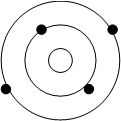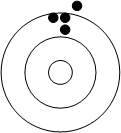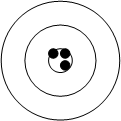Accuracy
The definition of accuracy is essentially having results (data) that is centered on a target value. Statistically speaking, it is how correct the mean value is.
It is often confused with “precise.” The layman’s definition of precision is “a measure of how little variation there is in your system”.
Lean Six Sigma depends heavily on understanding both of these concepts. When a process is not delivering consistently acceptable results, you likely are dealing with either inaccuracy or an imprecise process.

Statistically, this shot group from a rifle is fairly accurate—its average is fairly close to the center of the target.

Figure 1. Accurate, but not precise
You would interpret this to mean that the system has a great deal of variation but is centered over the target. Accuracy is a term that is often, in practical application, combined with precision. Most people would not look at Figure 1 and immediately think of how accurate the shooter was, despite the centering of the average. They tend to think, incorrectly, that the group must be precise as well before they consider it accurate.
Figure 2 is much more precise than the one above.

Figure 2. Precise, but not accurate
In general, imprecise processes are easier to fix than inaccurate processes. The pictures give a good understanding of this. I would feel more confident in rapidly finding a means of moving the precise shot group in Figure 2 towards the center than in tightening up the shot group in Figure 1.
To zero a rifle, the Army uses an approach that addresses accuracy and precision. Soldiers fire 3 rounds. No adjustments are made to the rifle until the soldier can fire those 3 rounds in a very tight shot group, regardless of where they are hitting the target.
Only when the variation has been removed from the soldier’s shooting process does the soldier adjust the sights on the rifle to move the shot group to the center of the target, as in Figure 3.

Figure 3. Centered. Accurate and precise.
So, what does this mean to you in the world of continuous improvement? Well, imagine you are in the business of making rulers. You want each ruler to be exactly one foot long. An accurate process would average out to 12 inches, but might have a significant amount of spread in the actual dimensions (i.e. a run of rulers measuring 9, 10, 14, 12, 15, 11, and 13 inches averages out to 12 inches, but would be very hard to sell). Fixing this process would likely require a great deal of work to remove the variation.
A precise but inaccurate process might put out all rulers at exactly 14”. It is likely much easier to fix this process. Perhaps the wrong length stock is used, or an index mark is not properly aligned in a cutter.
Often, fixing this sort of condition is simply a matter of finding the root cause and then adjusting the equipment to move the average.


2 Comments
StraightArrow1 · December 15, 2010 at 7:28 am
Definition: Accuracy
Typographical error, 1st paragraph:
The layman’s definition of precision is “a measure of how little variation there is in a your system”.
Note: “there is in a your system.”
“a your” – one of the words needs to be eliminated.
Respectfully
Mike
Jeff Hajek · December 15, 2010 at 7:41 am
Mike,
Many thanks for helping me find the defect. Now, if only I could figure out a foolproof way to eliminate the a my errors in the first place…
Regards,
Jeff